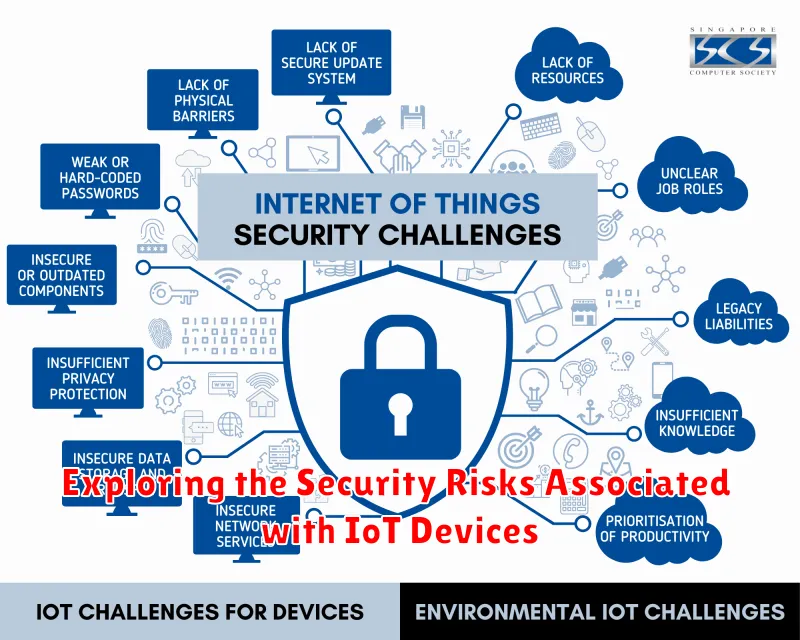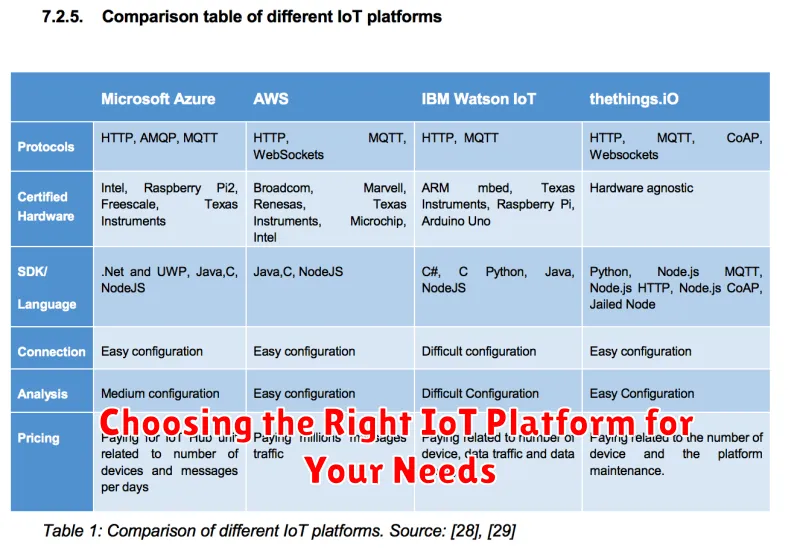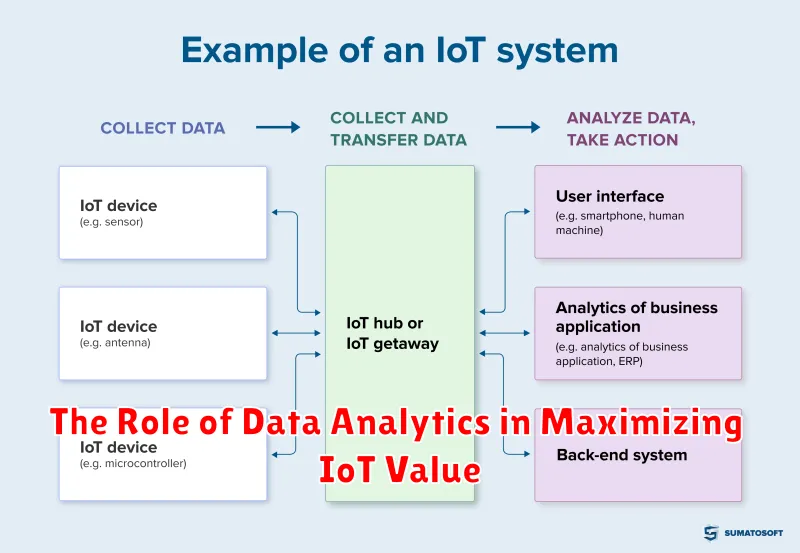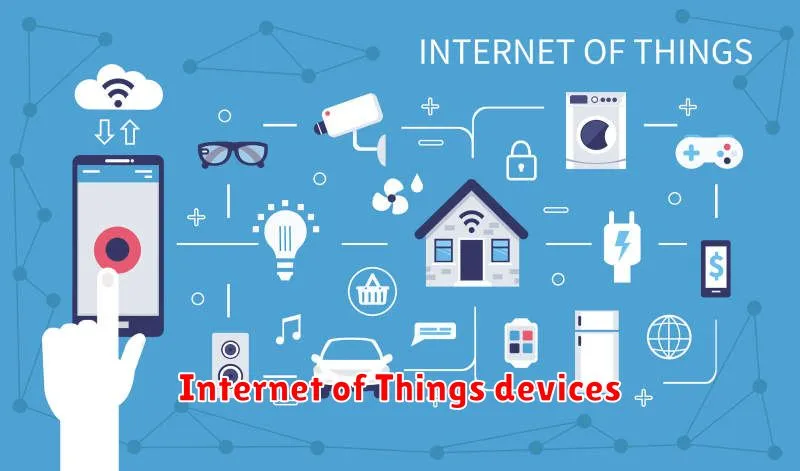In today’s technologically advanced world, we’re constantly surrounded by connected devices that seamlessly integrate into our daily lives. From smart homes and wearables to industrial automation and smart cities, the Internet of Things (IoT) has revolutionized the way we interact with the world. But beyond the convenience and innovation, the true power of IoT lies in the connections it fosters – connections between devices, data, and people.
This article dives deep into the fascinating realm of IoT devices, exploring their capabilities, benefits, and the transformative impact they’re having across various industries. We’ll uncover the intricate network of interconnected devices, examine the vast amounts of data they generate, and delve into the possibilities that arise when these connections are harnessed effectively. Join us as we unlock the potential of IoT and explore its role in shaping our future.
Common Examples of IoT Devices in Everyday Life
The Internet of Things (IoT) is rapidly transforming our everyday lives, connecting our devices, homes, and even cities. From smart assistants to connected appliances, IoT devices are becoming increasingly prevalent, offering convenience, efficiency, and a whole new level of connectivity. Let’s explore some common examples of IoT devices that are seamlessly integrated into our daily routines.
Smart Home Devices:
- Smart Speakers: Devices like Amazon Echo and Google Home act as central hubs for controlling other smart home devices, playing music, setting reminders, and even providing weather updates.
- Smart Lighting: With the help of IoT, you can now dim, brighten, and even change the color of your lights remotely through smartphone apps or voice commands.
- Smart Thermostats: These devices learn your heating and cooling preferences and automatically adjust the temperature based on your schedule, saving you energy and money.
Wearable Technology:
- Smartwatches: These wrist-worn devices track your fitness activity, monitor your heart rate, and even send notifications from your smartphone.
- Fitness Trackers: These devices monitor your steps, distance, calories burned, and sleep patterns, helping you achieve your fitness goals.
Connected Appliances:
- Smart Refrigerators: These appliances allow you to check your food inventory, monitor expiration dates, and even order groceries online.
- Smart Washing Machines and Dryers: These machines connect to your Wi-Fi network, allowing you to start and stop cycles remotely, receive notifications when cycles are complete, and even monitor energy usage.
Transportation:
- Connected Cars: Modern cars are equipped with features like GPS navigation, real-time traffic updates, and even automatic emergency braking systems.
Other Examples:
- Smart Security Systems: These systems use motion sensors, cameras, and other IoT devices to detect intruders and alert you through your smartphone.
- Smart Home Security Cameras: These cameras provide you with remote access to view your home from anywhere in the world, enhancing your security.
These are just a few examples of the many IoT devices that are transforming our daily lives. As technology continues to evolve, we can expect even more innovative and connected devices to emerge, making our lives easier, more convenient, and more efficient.
Benefits of Using IoT Devices for Businesses and Consumers
The Internet of Things (IoT) is rapidly transforming the way we live and work. With the ability to connect everyday objects to the internet, IoT devices are opening up a world of possibilities for both businesses and consumers. From smart homes to connected factories, IoT is revolutionizing industries and enhancing our daily lives. Here are some key benefits of using IoT devices:
For Businesses:
- Improved Efficiency and Productivity: IoT devices can automate tasks, optimize processes, and provide real-time data for informed decision-making, leading to increased efficiency and productivity.
- Enhanced Customer Experience: Businesses can leverage IoT to offer personalized services, predict customer needs, and provide a more seamless and engaging customer experience.
- Cost Savings: By optimizing resource usage, reducing waste, and streamlining operations, IoT can help businesses save money and improve profitability.
- Competitive Advantage: Early adopters of IoT can gain a competitive edge by leveraging its capabilities to innovate, differentiate themselves, and meet evolving customer demands.
For Consumers:
- Convenience and Comfort: IoT devices can simplify daily tasks, provide entertainment, and enhance home comfort, making our lives easier and more enjoyable.
- Increased Safety and Security: Smart home devices like security cameras and door locks can enhance safety and security, providing peace of mind and protection from potential threats.
- Improved Health and Wellness: Wearable fitness trackers and smart health devices can monitor our health, provide personalized insights, and encourage healthier lifestyles.
- Enhanced Accessibility: IoT devices can provide assistive technologies for people with disabilities, enabling them to participate more fully in society.
As the IoT landscape continues to evolve, we can expect even more innovative applications and benefits. From connected cars to smart cities, the potential of IoT is boundless, offering endless opportunities to improve our lives and shape the future.
Key Considerations for Implementing IoT Solutions
The Internet of Things (IoT) is transforming industries and changing the way we live. As more devices connect to the internet, the potential for innovation and efficiency is vast. However, successfully implementing IoT solutions requires careful planning and consideration. Here are some key factors to keep in mind:
Security
Security is paramount in any IoT deployment. With sensitive data flowing between devices and the cloud, robust security measures are essential. Data encryption, access control, and regular security audits are crucial to protect your network and data from cyberattacks.
Data Management
IoT devices generate a massive amount of data. Effective data management strategies are needed to store, analyze, and utilize this data effectively. This includes selecting the right data storage solutions, developing data analysis capabilities, and ensuring data integrity.
Scalability
IoT deployments can grow rapidly. Ensure your solutions are scalable to accommodate future expansion. This means using infrastructure and technologies that can handle increasing data volumes and device connections.
Interoperability
IoT ecosystems often involve devices from multiple vendors. Choosing solutions with interoperability in mind is crucial. This ensures that different devices can communicate and share data seamlessly.
Integration
Successfully integrating IoT solutions with existing systems is vital. Consider the integration process, including data mapping, API connections, and potential compatibility issues.
Cost
Implementing IoT solutions can involve significant costs. Carefully evaluate the costs associated with hardware, software, connectivity, maintenance, and ongoing support.
Return on Investment (ROI)
Define clear ROI goals for your IoT project. Determine the expected benefits, such as increased efficiency, reduced costs, or improved customer experience. This will help you justify the investment and track the project’s success.
By carefully considering these key factors, you can ensure a successful and impactful IoT implementation.
The Future of IoT and Its Impact on Various Industries

The Internet of Things (IoT) is rapidly transforming the way we live, work, and interact with the world around us. By connecting physical devices to the internet, IoT enables a seamless flow of data, paving the way for unprecedented levels of automation, efficiency, and innovation across various industries. As we delve deeper into the realm of interconnected devices, it becomes increasingly apparent that the future of IoT holds immense potential to revolutionize the way we operate in diverse sectors.
One of the most significant impacts of IoT is in the realm of manufacturing. By connecting machines and sensors on the factory floor, manufacturers can gain real-time insights into production processes, optimize operations, and identify potential issues before they arise. This data-driven approach leads to increased efficiency, reduced downtime, and improved product quality. Moreover, IoT facilitates the development of smart factories, where robots and automated systems work in tandem to streamline production and enhance overall productivity.
The healthcare industry is also undergoing a profound transformation driven by IoT. Wearable devices, such as smartwatches and fitness trackers, empower individuals to monitor their health in real-time, enabling early detection of potential health issues and personalized healthcare solutions. In hospitals, IoT sensors can track patient vital signs, automate medication delivery, and improve overall patient care. Remote patient monitoring systems leveraging IoT technologies allow healthcare professionals to provide continuous care from a distance, enhancing access to medical expertise for patients in remote locations.
The energy sector is another area where IoT is poised to make a significant contribution. Smart grids, powered by IoT sensors and communication technologies, enable real-time monitoring and management of energy consumption, leading to greater efficiency and reduced energy waste. This has a positive impact on both individual consumers and the environment. Furthermore, IoT facilitates the development of renewable energy sources, such as solar and wind power, by optimizing energy generation and distribution processes.
In the transportation industry, IoT is transforming the way we travel. Connected vehicles equipped with sensors and communication systems can communicate with each other and infrastructure, enabling safer and more efficient transportation. This includes features like autonomous driving, traffic flow optimization, and real-time vehicle diagnostics. Moreover, IoT plays a crucial role in developing smart cities, where transportation systems are interconnected to improve traffic flow, reduce congestion, and enhance overall urban mobility.
As the IoT ecosystem continues to grow and evolve, the impact of connected devices will be felt across every aspect of our lives. From personalized shopping experiences and smart homes to improved agricultural practices and disaster response systems, IoT has the potential to address some of the world’s most pressing challenges while simultaneously enhancing our quality of life. The future of IoT is bright, and its impact on various industries is set to be transformative, shaping the world as we know it.
Exploring the Security Risks Associated with IoT Devices

The Internet of Things (IoT) has revolutionized how we interact with our surroundings, connecting devices to the internet and enabling seamless communication between them. From smart home appliances to wearable fitness trackers, IoT devices offer unprecedented convenience and functionality. However, alongside these benefits lies a crucial concern: security. The interconnected nature of IoT devices introduces vulnerabilities that can be exploited by malicious actors, posing significant threats to both individuals and organizations.
One primary security risk associated with IoT devices is their inherent vulnerability to hacking. Many IoT devices are designed with weak security protocols and lack proper authentication mechanisms. This makes them susceptible to unauthorized access, allowing hackers to gain control and potentially steal sensitive data, disrupt operations, or even cause physical harm. For example, a hacker could gain access to a home security system and disable its functionality, leaving the residents vulnerable to theft.
Another significant concern is the lack of standardization and interoperability within the IoT ecosystem. Different manufacturers use varying security protocols and encryption methods, creating a fragmented landscape that makes it difficult to implement robust security measures. This fragmented landscape also complicates the task of managing and securing large-scale deployments of IoT devices, increasing the risk of security breaches.
Furthermore, IoT devices often collect and transmit vast amounts of personal and sensitive data, which can be exploited for malicious purposes. From location data to health information, this data can be used to track individuals, target them with tailored attacks, or even be sold on the black market. The potential for data breaches and privacy violations is a major concern for users of IoT devices.
Finally, the rapid pace of innovation in the IoT space often outpaces security considerations. Manufacturers may prioritize functionality and affordability over security, resulting in devices with inherent vulnerabilities. This is particularly concerning as the number of connected devices continues to grow exponentially, expanding the attack surface and increasing the risk of security breaches.
In conclusion, while IoT devices offer numerous benefits, it is crucial to acknowledge and address the associated security risks. By implementing robust security protocols, prioritizing data privacy, and fostering greater standardization within the industry, we can unlock the full potential of IoT while mitigating the risks and ensuring a secure and connected future.
Choosing the Right IoT Platform for Your Needs

In the world of interconnected devices, choosing the right IoT platform is paramount to success. This decision hinges on a careful evaluation of your specific project requirements and the capabilities of various platforms. It’s about finding the right fit that aligns with your vision, budget, and long-term goals.
To make an informed choice, consider the following key factors:
- Scalability: As your IoT network expands, your platform should be able to handle the growing volume of data and devices.
- Security: Robust security features are essential to protect sensitive data and prevent unauthorized access.
- Integration: Seamless integration with your existing systems and third-party services is crucial for a smooth workflow.
- Development Tools: The platform should offer developer-friendly tools and resources to simplify application development and deployment.
- Data Analytics: Comprehensive data analytics capabilities allow you to derive valuable insights from the collected data.
- Cost: Evaluate the platform’s pricing structure, including subscription fees, data storage costs, and other potential expenses.
Once you have a clear understanding of your needs, you can explore different IoT platforms and compare their strengths and weaknesses. Some popular options include:
- AWS IoT: A comprehensive platform offered by Amazon Web Services, providing a wide range of services for device management, data processing, and analytics.
- Microsoft Azure IoT: A robust platform from Microsoft, offering various services for device connectivity, data ingestion, and application development.
- Google Cloud IoT: Google’s platform for building and managing IoT solutions, featuring strong capabilities in data analysis and machine learning.
- IBM Watson IoT: IBM’s platform focused on cognitive computing and artificial intelligence, enabling advanced insights and automation.
Remember, the right IoT platform is not a one-size-fits-all solution. Take your time to research, evaluate, and choose the platform that best meets your specific needs and aspirations. This strategic decision will pave the way for a successful and transformative IoT journey.
Real-World Applications of IoT Across Different Sectors

The Internet of Things (IoT) is revolutionizing how we live, work, and interact with the world around us. This transformative technology connects physical objects, devices, and systems to the internet, enabling them to collect, exchange, and analyze data in real-time. This interconnectedness unlocks a vast array of possibilities across various sectors, driving innovation and efficiency.
Smart Homes
IoT is transforming our homes into smart spaces, enhancing comfort, security, and energy efficiency. Smart home devices like smart thermostats, security cameras, and lighting systems can be controlled remotely, allowing homeowners to adjust settings, monitor activity, and optimize energy consumption.
Healthcare
In the healthcare sector, IoT is enabling personalized medicine, remote patient monitoring, and improved diagnostics. Wearable health trackers collect vital signs like heart rate, sleep patterns, and activity levels, providing valuable insights to patients and healthcare professionals. Remote patient monitoring devices allow doctors to track patients’ conditions from afar, enabling timely interventions and improving overall health outcomes.
Manufacturing
IoT is revolutionizing manufacturing processes, improving efficiency, productivity, and safety. Smart sensors can monitor equipment performance, detect anomalies, and predict maintenance needs, minimizing downtime and reducing costs. Automated guided vehicles (AGVs) streamline material handling, optimizing logistics and reducing human error.
Agriculture
In agriculture, IoT is playing a crucial role in optimizing crop yields and resource management. Smart irrigation systems utilize sensors to monitor soil moisture and weather conditions, ensuring efficient water usage. Precision farming technologies use drones and sensors to collect data on soil health, plant growth, and pest infestations, enabling farmers to make data-driven decisions and improve yields.
Transportation
IoT is transforming transportation systems, improving safety, efficiency, and connectivity. Connected cars are equipped with sensors that enable features like collision avoidance, lane departure warnings, and emergency braking, enhancing safety on the roads. Smart traffic management systems use sensors and data analytics to optimize traffic flow, reduce congestion, and minimize travel time.
Conclusion
The IoT is a powerful force that is reshaping industries and improving our lives. From smart homes to healthcare, manufacturing to agriculture, and transportation to countless other sectors, the transformative potential of interconnected devices is immense. As technology continues to evolve, we can expect even more innovative applications of IoT to emerge, further enhancing our world and driving progress.
How IoT is Transforming Business Operations and Customer Experiences
The Internet of Things (IoT) is rapidly changing how businesses operate and interact with their customers. By connecting physical devices to the internet, IoT enables businesses to collect real-time data, automate processes, and gain valuable insights that were previously impossible. This transformative technology is impacting nearly every industry, from manufacturing and healthcare to retail and transportation.
One of the most significant ways IoT is transforming business operations is through increased efficiency and productivity. By connecting devices and systems, businesses can automate tasks, optimize processes, and eliminate manual labor. For example, in manufacturing, IoT sensors can monitor equipment performance, detect anomalies, and trigger preventative maintenance before breakdowns occur. This reduces downtime, improves productivity, and lowers operational costs.
IoT also enhances customer experiences by providing personalized services, improved responsiveness, and increased convenience. For example, smart home devices can be controlled remotely, allowing customers to adjust lighting, temperature, and security settings from their smartphones. In retail, IoT beacons can track customer movement within stores and send targeted promotions based on their preferences. This personalized approach enhances the shopping experience and drives customer loyalty.
Beyond efficiency and customer experience, IoT is also driving innovation and new business models. Companies are using IoT data to develop new products and services, optimize supply chains, and create new revenue streams. For example, smart cities are using IoT sensors to monitor traffic flow, manage energy consumption, and improve public safety. This data-driven approach is revolutionizing how cities operate and deliver services to their citizens.
While the possibilities with IoT are vast, it’s important to note the potential challenges. Security is a major concern, as connected devices are vulnerable to cyberattacks. Data privacy is another crucial issue, as businesses must ensure that they handle customer data responsibly and ethically. Integration can also be complex, as connecting different systems and devices can be challenging.
Despite these challenges, the potential benefits of IoT are undeniable. As the technology continues to evolve and mature, it will undoubtedly reshape businesses and industries in profound ways. By embracing the power of connection and harnessing the insights gained from IoT data, businesses can unlock new levels of efficiency, innovation, and customer satisfaction.
The Role of Data Analytics in Maximizing IoT Value

The Internet of Things (IoT) has revolutionized the way we live, work, and interact with the world around us. But simply connecting devices is not enough. To truly unlock the power of IoT, we need to harness the vast amount of data generated by these interconnected devices. That’s where data analytics comes in.
Data analytics plays a crucial role in maximizing the value of IoT by transforming raw data into actionable insights. By analyzing data collected from IoT devices, businesses can gain a deeper understanding of their operations, customer behavior, and environmental factors. This intelligence allows them to make informed decisions, optimize processes, and create new revenue streams.
Here are some key ways data analytics enhances IoT value:
- Predictive Maintenance: By analyzing sensor data from machines and equipment, businesses can predict potential failures before they occur. This allows for proactive maintenance, minimizing downtime and reducing costs.
- Improved Efficiency: Data analytics helps optimize resource utilization and streamline processes. For example, analyzing energy consumption data from smart grids can identify areas for improvement and reduce energy waste.
- Personalized Experiences: Data from connected devices can be used to personalize customer experiences. For instance, smart home devices can learn user preferences and adjust settings accordingly.
- Enhanced Security: Data analytics plays a vital role in identifying and mitigating security threats in IoT ecosystems. By analyzing network traffic and device behavior, potential vulnerabilities can be detected and addressed proactively.
- Data-Driven Innovation: The insights gained from data analytics fuel innovation by providing a foundation for developing new products, services, and business models.
As the IoT landscape continues to expand, the role of data analytics becomes even more critical. By leveraging the power of data, organizations can unlock the full potential of connected devices and drive significant value across industries.

